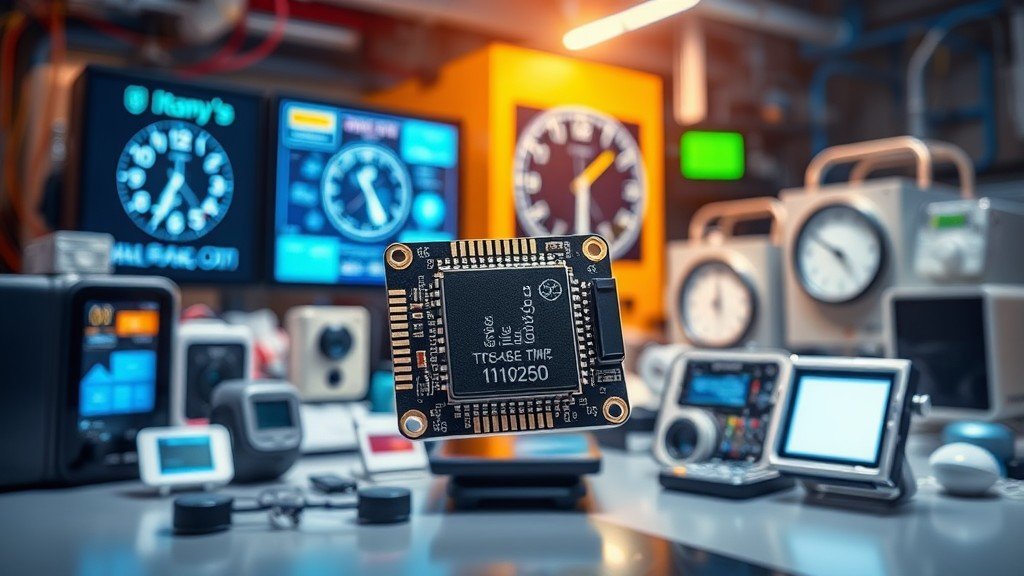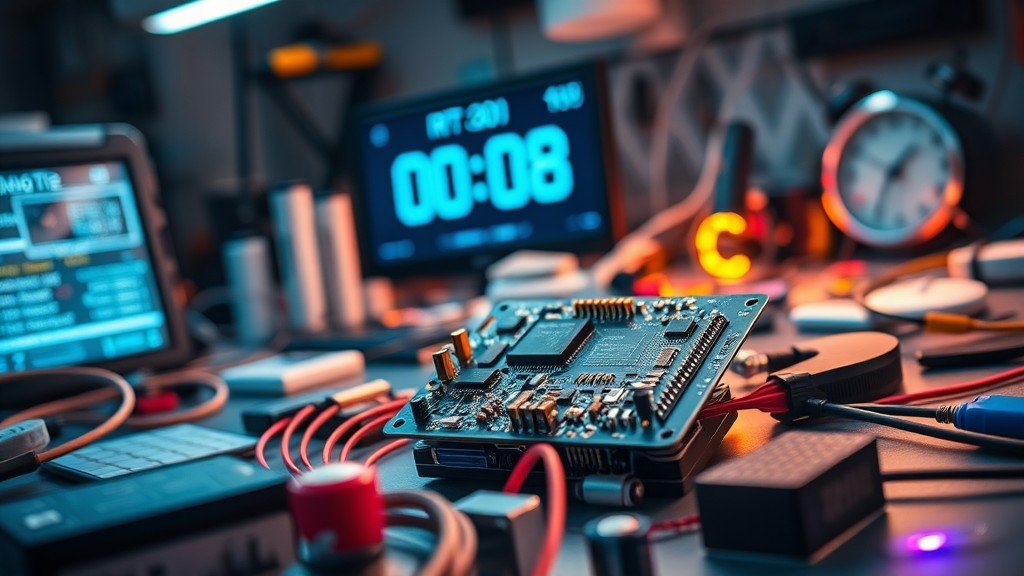Real-time clocks, or RTCs, are neat gadgets that keep time even when everything else is turned off. Imagine a clock that doesn’t need batteries or power to work. That’s what RTCs do!
They are very important in science and technology, helping researchers and engineers do their jobs better. Each tick of an RTC helps keep our world in sync. Want to find out more about these amazing tools? Keep reading for more information!
Key Takeaway:
- RTCs help keep accurate time, even when devices are off.
- They are crucial in scientific research and technology.
- New tech like atomic clocks is making RTCs even better.
What is a Real-Time Clock (RTC)?
Credits: ALL ABOUT ELECTRONICS
A real-time clock, or RTC, is a small timekeeper found in many devices. It uses a quartz crystal oscillator to keep time accurately. Even when a device is turned off, the RTC keeps ticking. Here are the important parts of an RTC:
- Controller: This is the brain that helps manage the time.
- Oscillator: It creates a steady beat for keeping time.
- Quartz Crystal: This part helps with precise timing through tiny vibrations.
What happens if there were no RTCs? Many devices wouldn’t know the time, especially when they are asleep or turned off.(1)
Functions of RTCs

Many people think RTCs are just for telling time, but they do much more! Here are some key functions they perform:
- Time Tracking: RTCs keep track of time even when the device is off.
- Alarms and Timers: They can wake up devices at the right time to do tasks.
- Power Management: RTCs help devices save battery by allowing them to sleep without losing track of time.
How would gadgets work without these functions? RTCs are very useful for all kinds of devices!
Applications in Scientific and Technical Fields
Now, let’s look at where RTCs are used in science and technology. They play a big role in many areas, such as:
- GPS Systems: Accurate time is very important for finding your way.
- Weather Stations: RTCs log weather data with exact timestamps.
- Medical Devices: In hospitals, they ensure treatments and monitoring happen at the right time.
- IoT Devices: RTCs help keep connected devices in sync, which is great for collecting data.
Have you thought about how many devices are used every day? RTCs help all these devices know what time it is!
Specialized Applications
In research, RTCs have some interesting uses. For example, in particle accelerators, scientists need precise timing for their experiments. This is where RTC engineering comes in. They create special RTCs that support high-energy physics. It’s like having a super accurate watch for very important experiments!
How do these applications show the importance of RTCs? They are vital in both everyday life and advanced science. RTCs help keep everything running smoothly and on time.
Recent Developments
Recently, there have been exciting advancements in RTC technology. One major breakthrough is the chip-scale atomic clock. These clocks are incredibly precise—so precise that they can keep time within 50 parts per trillion!
What does this level of accuracy mean? It is fantastic for things like celestial navigation. However, they are a bit more expensive and use more power than regular RTCs. Despite this, they help scientists achieve amazing results.
General Overview of RTCs
- Definition: RTCs are electronic devices that track time accurately, even when powered off. They usually consist of a quartz oscillator, a circuit, and a backup battery.
- Accuracy: Most RTCs have an accuracy of about 8.6 to 1.7 seconds per day. Some are even better than that!
Why is this accuracy important? In scientific experiments, timing can make a big difference. RTCs ensure that everything runs on schedule, helping scientists and researchers get the best results possible.
Scientific Applications
Now let’s look at more examples of how RTCs are used in science:
- Data Logging: RTCs help data logging devices by giving each piece of data a precise time. This timing is very important for experiments.
- Environmental Monitoring: In tracking air and water quality, RTCs timestamp measurements. This helps scientists understand changes over time.
- Space Exploration: As we explore farther into space, accurate clocks become even more critical. New atomic clocks are being designed to assist with these missions.
How do these applications show the importance of RTCs in science? They help ensure that data is accurate and reliable, which is essential for making discoveries.
Importance in Research
RTCs are not just cool gadgets; they help scientists do their work better. Here are some ways they support research:
- Facilitating Experiments: Researchers can conduct experiments that require very precise timing, like synchronizing multiple instruments.
- Space Missions: As missions go deeper into space, highly accurate clocks, like atomic clocks, are developed. They ensure everything runs on time!
How do these clocks help scientists? They are the unsung heroes behind many scientific breakthroughs. RTCs make sure that scientists can focus on their important work without worrying about time!(2)
Conclusion
Real-time clocks are essential for modern technology, especially in scientific fields. They keep time accurately and help devices run smoothly, whether it’s a GPS, medical device, or a complex scientific instrument. As technology advances, RTCs will continue to play a key role in supporting innovative applications and research. So, next time you check the time, remember there’s a little RTC working hard behind the scenes!
FAQ
How do real time clocks enhance applied science and computer science applications?
Real time clocks (RTCs) are essential in applied science because they keep accurate time for experiments and data collection. In computer science, RTCs help improve the performance of operating systems by keeping everything in sync. This timing is especially important for application development and artificial intelligence, where quick data processing can make a big difference in results.
What educational programs related to RTC engineering are available at Renton Technical College?
At Renton Technical College, students can enroll in a BAS in application development that includes learning about real time clocks. This program teaches important computer programming skills needed to use RTCs in technology centers. Students discover how RTC engineering supports high performance in various fields, including applied science and artificial intelligence.
How do technology centers utilize RTCs for advancements in artificial intelligence?
Technology centers use real time clocks to improve artificial intelligence systems by ensuring they process data accurately and on time. This precise timing is crucial for achieving high performance in operating systems and helps AI make quick decisions. By applying RTC engineering, these centers enhance their systems, benefiting both applied science and general education.
What are some common applications of RTCs in scientific research and general education settings?
In scientific research, real time clocks are found in devices like weather stations and medical equipment, where they log data accurately over time. In general education, RTCs help students learn about the importance of timing in technology. These applications show how RTC engineering improves both applied science and computer programming skills across different areas.
How do real time clocks enhance applied science and computer science applications?
Real time clocks (RTCs) are very important in applied science because they help keep accurate time for experiments and data collection. In computer science, RTCs improve the performance of operating systems by making sure everything stays in sync. This precise timing is especially crucial for application development and artificial intelligence, where quick data processing can greatly affect the results.
What educational programs related to RTC engineering are available at Renton Technical College?
At Renton Technical College, students can take a BAS in application development that includes studying real time clocks. This program teaches essential computer programming skills needed to work with RTCs in technology centers. Students learn how RTC engineering supports high performance in various fields, including applied science and artificial intelligence.
How do technology centers utilize RTCs for advancements in artificial intelligence?
Technology centers use real time clocks to enhance artificial intelligence systems by ensuring they process data accurately and on time. This precise timing is vital for achieving high performance in operating systems and helps AI make quick decisions. By using RTC engineering, these centers improve their systems, benefiting both applied science and general education.
What are some common applications of RTCs in scientific research and general education settings?
In scientific research, real time clocks are used in devices like weather stations and medical equipment to log data accurately over time. In general education, RTCs help students understand the importance of timing in technology. These examples show how RTC engineering enhances both applied science and computer programming skills across different areas.
Why are accurate timestamps important for data collection in scientific experiments?
Accurate timestamps from real time clocks are essential for collecting data during scientific experiments. They ensure that each piece of information is recorded at the right moment, which helps researchers analyze trends over time. This accuracy allows scientists to understand relationships within their experiments better, leading to more reliable conclusions.
References
- https://www.earthdata.nasa.gov/data-recipes/radiometrically-terrain-correct-sentinel-1
- https://www.embeddedrelated.com/showarticle/162.php


